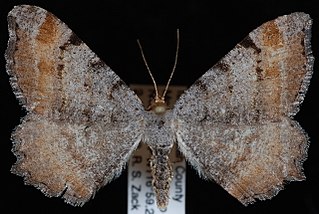| Rindgea subterminata | |
|---|---|
| Scientific classification | |
| Kingdom: | Animalia |
| Phylum: | Arthropoda |
| Class: | Insecta |
| Order: | Lepidoptera |
| Family: | Geometridae |
| Genus: | Rindgea |
| Species: | R. subterminata |
| Binomial name | |
| Rindgea subterminata (Barnes & McDunnough, 1913) | |
| Synonyms [1] | |
| |
Rindgea subterminata is a species of moth in the family Geometridae first described by William Barnes and James Halliday McDunnough in 1913. [1] [2] [3] It is found in North America. [1]

Moths are a polyphyletic group of insects that includes all members of the order Lepidoptera that are not butterflies, with moths making up the vast majority of the order. There are thought to be approximately 160,000 species of moth, many of which have yet to be described. Most species of moth are nocturnal, but there are also crepuscular and diurnal species.
A species description is a formal description of a newly discovered species, usually in the form of a scientific paper. Its purpose is to give a clear description of a new species of organism and explain how it differs from species which have been described previously or are related. The species description often contains photographs or other illustrations of the type material and states in which museums it has been deposited. The publication in which the species is described gives the new species a formal scientific name. Some 1.9 million species have been identified and described, out of some 8.7 million that may actually exist. Millions more have become extinct.
William David Barnes was an American entomologist and surgeon. He was the son of Dr. William A. and Eleanor Sawyer Barnes. He graduated salutatorian from the Decatur High School in 1877. Then spent a year at Illinois State University followed by a year at University of Illinois. In 1879, he entered Harvard Medical School and graduated in 1886. While at Harvard, he met naturalist Louis Agassiz and his love of Lepidoptera grew. Agassiz taught him how to preserve and classify the butterflies. He completed an internship at Boston City Hospital and then studied abroad in Heidelberg, Munich and Vienna. In 1890, Dr. Barnes came home to Decatur and opened his medical practice. That same year he married Charlotte L. Gillette. The couple had two children: William Barnes Jr., and Joan Dean Gillett Barnes.
The MONA or Hodges number for Rindgea subterminata is 6413. [4]





